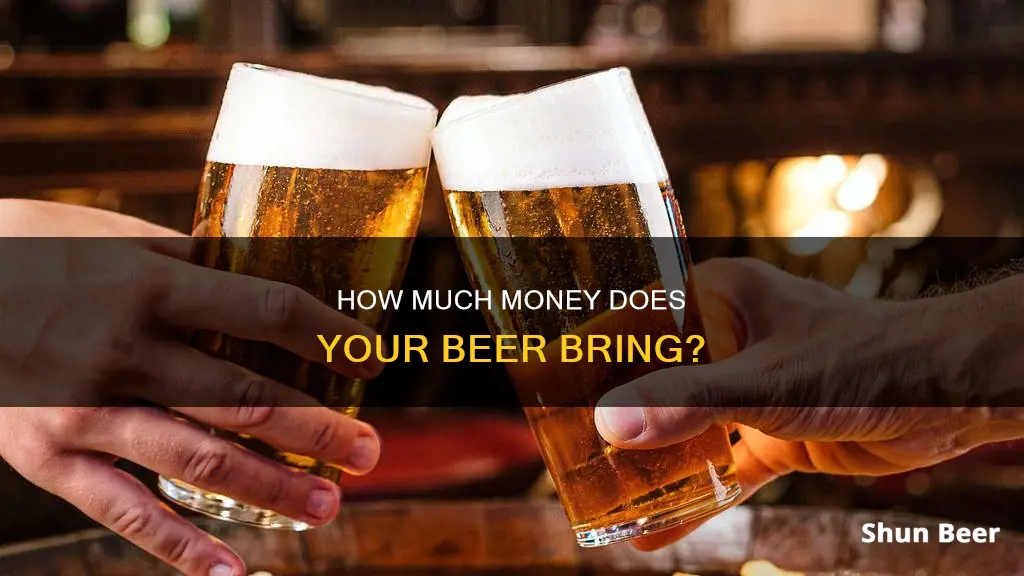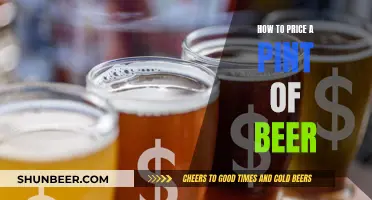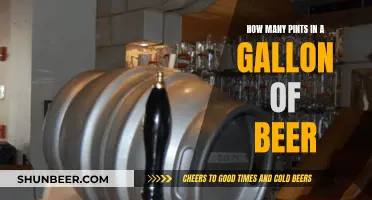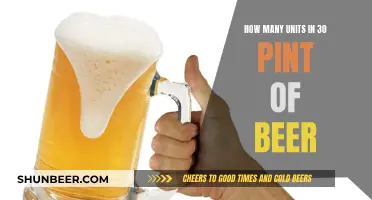
The markup on a pint of beer varies depending on the type of beer, the establishment, and the region. On average, the markup on beer is about 200% to 300%, similar to restaurant wine markups. Bottled and canned beer are typically marked up by a fixed amount, such as 50 cents or a dollar, or by a percentage, with a target liquor cost of 20% to 30%. Draft beer, on the other hand, tends to have a higher markup due to its higher overhead expenses, with profit margins as high as 80%. The cost of a pint of beer is influenced by various factors, including the type of beer, serving size, overhead charges, and competition, ultimately aiming to balance profitability and customer satisfaction.
| Characteristics | Values |
|---|---|
| Average markup | 200% to 300% |
| Bottled beer profit margin | 75% |
| Draft beer profit margin | 80% |
| Average pour cost for bottled beer | 25% |
| Average pour cost for draft beer | 20% |
| Wholesale cost per bottle | $1 |
| Wholesale cost per case of beer | $25.99 |
| Average cost to serve bottled beer | 25% |
| Average cost to serve draft beer | 20% |
What You'll Learn

The average markup on beer is 200% to 300%
The markup on beer varies depending on the type of beer and the establishment. Bottles and cans of macro brew, for instance, can be marked up to 500% because they are so cheap to buy wholesale. On the other hand, craft beers are often expensive wholesale, so bars don't mark them up as much. The profit margin for bottled beer should be around 75%, while the profit margin for draft beer should be about 80%.
The cost-per-ounce for beer in kegs is 40 to 45% less than for beer in cans or bottles. This means that the draft beer price aims for a much higher profit. However, draft beer also has higher overhead expenses. Installing and maintaining draft system equipment can be costly, and bars also need to regularly purchase CO2 and Nitrogen to serve their beer.
When pricing beer, it's important to consider the competition. If a bar is selling beer for significantly more than another venue down the street, customers may go elsewhere. It's also important to keep in mind the brewery's pricing if it's located nearby.
UK Beer Basics: Pints to Litres
You may want to see also

Macro brew bottles/cans can be marked up to 500%
When it comes to macro brew bottles and cans, the markup can be quite significant. In fact, it is not uncommon for these beverages to be marked up by as much as 500%. This may seem like a large number, but there is a good reason for it.
Macro brew beverages are typically very inexpensive to purchase wholesale. As a result, bars and restaurants have more flexibility in how much they charge their customers. The high markup on these drinks can help to cover the costs of operating the establishment, including rent, labour, and other overhead expenses. It is important for businesses to ensure that their markup is sufficient to cover lower-price times, such as happy hour.
Additionally, the markup on macro brew bottles and cans can help to offset the lower profit margins on other types of beer, such as craft beers. Craft beers tend to be more expensive to purchase wholesale, so bars typically do not mark them up as high. By marking up macro brew beverages, bars can maintain a healthy profit margin overall.
It is worth noting that the markup on beer can vary depending on the type of beer and the establishment. The average markup on beer is about 200% to 300%, but this can range from 200% to 500% or more. Ultimately, the markup on macro brew bottles and cans is a strategy used by bars and restaurants to maximize their profitability while offering customers a variety of beverage options.
The Anatomy of a Beer Cask: Understanding Its Parts
You may want to see also

Draft beer has higher overhead expenses
When it comes to pricing beer, there are several factors to consider, and one of the main distinctions is between draft and bottled beer. While the pricing strategy for both types of beer is the same—aiming for a liquor cost of 20% to 30%—draft beer has higher overhead expenses that need to be factored in.
One of the key reasons draft beer has higher overhead costs is the equipment and maintenance involved. Installing and maintaining draft system equipment can be expensive, from weekly line cleaning to frequent keg changing and accurate beer keg tracking. Additionally, the purchase of CO2 and nitrogen is a regular expense to ensure the beer is properly served.
Another factor contributing to the higher overhead of draft beer is spillage and spoilage. This is a significant consideration when determining the beer price, as it directly impacts the overall cost.
Furthermore, the variety of keg sizes available for draft beer adds to the overhead expenses. The typical keg size in the US is a half barrel, approximately 15.5 gallons, but there are also European imports of around 13.2 gallons and quarter kegs of about 7.75 gallons. The cost of a keg can vary depending on the type of beer, with domestic kegs costing around $100 and craft beer kegs ranging from $100 to $200 or more.
To ensure profitability, it is crucial to set the right price for draft beer. While draft beer offers flexibility and the potential for high profit margins, the higher overhead expenses must be covered. This involves considering the cost of the keg, the serving size, and the desired pour cost to determine the retail price and, ultimately, the cost per pint.
In summary, draft beer has higher overhead expenses compared to bottled beer due to equipment and maintenance costs, the need for regular purchases of CO2 and nitrogen, spillage and spoilage, and the variety of keg sizes available. These factors must be taken into account when setting prices to ensure profitability while providing customers with a refreshing pint.
Beer Gas vs CO2: What's the Difference?
You may want to see also

The average cost to serve a bottled beer is 25%
Bottled beer is generally easier to price than draft beer because you're not dealing with finding the serving sizes. You can simply take the wholesale cost per bottle and multiply it by 2, 2.5, or 3, rounding to the nearest nickel, dime, or quarter. Alternatively, you can add a fixed overhead service charge of 50 cents or a dollar on top of the wholesale multiplier to get the menu price.
While bottled beer has lower profit margins than draft beer, it also has fewer overhead costs. Draft beer requires equipment and maintenance, and you'll need to purchase CO2 and Nitrogen regularly to keep your beer fresh. Additionally, there is often more spillage and spoilage with draft beer, which can cut into your profits.
When pricing bottled beer, it's important to consider your desired profit margins, the amount you make on any drink sold, the pour costs, and the cost of each drink. You'll also want to stay competitively priced with your local competition, so be sure to check out the prices at other bars and restaurants in your area.
By pricing your bottled beer competitively and ensuring that your pour costs and profit margins are in line with industry standards, you can maximize your profits and keep your customers happy.
Maryland Beer Taxes: How Much Do They Cost?
You may want to see also

The average cost to serve a draft beer is 20%
When pricing draft beer, it is important to consider the keg size. The typical keg size in the US is a half barrel, which is about 15.5 gallons, while European imports are typically around 13.2 gallons, and a quarter keg holds about 7.75 gallons. The cost of the keg and the serving size of the beer will determine the price you should charge.
To calculate the price per pint, first, determine how many beers are in each keg by dividing the number of ounces in the keg by the serving size. Then, divide the cost of the keg by your desired pour cost to get the retail price of the keg. Finally, divide the retail price for the keg by the number of beers the keg holds to get the cost per pint.
For example, let's say a keg costs $120 and the desired pour cost is 20%. The calculation would look like this:
- Keg size (1984 oz) ÷ serving size (14.5 oz) = 136 pints per keg
- $120 ÷ 0.20 = $600 (retail price for the entire keg)
- $600 ÷ 136 pints = $4.41 per pint (rounded up to $4.50)
It's important to note that the pricing of draft beer can vary depending on various factors such as the type of beer, the establishment, and customer demand. Additionally, the pricing of draft beer needs to cover the overhead expenses associated with serving draft beer, such as the cost of equipment, maintenance, and consumables like CO2 and nitrogen.
By pricing draft beer appropriately, taking into account both the cost structure and customer expectations, bars and restaurants can maximize their profitability while offering a compelling product to their customers.
Beer Buzz: Alcohol Content and the Feel-Good Factor
You may want to see also
Frequently asked questions
The average markup on beer is about 200% to 300% when considering beer prices for bars.
The profit margin for bottled beer should be around 75%.
The profit margin for draft beer should be about 80%.
You can calculate the price of bottled beer by taking the wholesale cost per bottle and multiplying it by 2, 2.5, or 3.
To calculate the price of draft beer, first determine how many beers are in each keg by dividing the number of ounces in the keg by the serving size. Then, take the cost of the keg and divide it by your desired pour cost to get the retail price. Finally, divide the retail price by the number of beers the keg holds to get the cost per pint.







